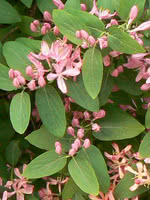Mon-Fri 9am - 5pm Mountain time
Echinacea vs Twining Honeysuckle
Echinacea angustifolia
Lonicera dioica
ONLY AVAILABLE BY CONTRACT GROW
ONLY AVAILABLE BY CONTRACT GROW
Echinacea is a unique flowering plant that has been used by Native Americans as medicine for centuries.
Tall stalks topped with badminton-birdie-like flowers make this plant a distinctive addition to any garden or yard.
Echinacea this drought tolerant and will attract bees, butterflies, birds and other wildlife.
Twining Honeysuckle is a vine native to the forests of Canada and the United States.
It can often be found winding up the bark of large trees or spreading out as a ground cover where no supports are present. You will love the attractive, yellow-orange flowers with pink centers which turn into red, inedible berries.
Consider Twining Honeysuckle when trying to achieve a natural, spreading, unkempt look for your garden.

